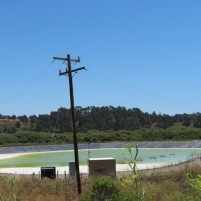Cambria is running out of time and money
September 15, 2015

Cambria brine pond
By JOSH FRIEDMAN
The Cambria Community Services District has just two and a half months before it will begin operating in the red, according to the district’s latest projections.
Cambria is currently strapped for cash as it tries to get a $13 million emergency water desalination project operating correctly. The rate payers voted to raise water rates at times the desalination plant is operating. However, because of engineering deficiencies the plant is rarely operational.
Meanwhile, the district is awaiting the arrival of $4.3 million in grant funds to offset rising costs. But, the grant funds may not arrive in time to keep the district in the black.
On Thursday, District General Manager Jerry Gruber told the board that the district would complete September with a balance of a little more than $600,000. The district’s balance sheet is slated to be negative $43 by the end of November if the grant money does not arrive, according to the latest projections.
On Tuesday evening, a district board subcommittee will discuss additional water and sewer rate increases, which are now under consideration. In addition to paying for the water project, the district will soon have to make sewer repairs.
Last year, water rates in Cambria effectively doubled. Prior to September 2014, the average monthly residential water bill was $48.02. The rate hike increased the average bill to $109.02 when the emergency water system is operating and to $85.02 when it is not.
The district constructed the water project under an emergency permit, but the supply system has thus far generated little water for Cambria residents. Earlier this year, the district operated the water system for about two and a half months. It had numerous flaws and needed to be shut down for repairs.
In particular, a pond is too small to effectively treat the brine laden water. The district paid engineering firm CDM Smith $500,000 to design and construct the pond and then agreed to pay another $500,000 to have the pond fixed.
The district still owes CDM Smith $1.5 million, Gruber said at the board meeting last week. The district has been deferring payments to water project contractors, a district staff reports states.
The emergency water supply project transforms a mix of fresh water, seawater, creek underflow and wastewater into potable water for residents.
In addition to containing a faulty design, the emergency water project prompted a costly lawsuit.
LandWatch of San Luis Obispo County sued the district last year, alleging the district breached state law by rushing through the project while skipping required components of an environmental review.
The district has spent $160,000 battling the lawsuit and plans to spend an additional $250,000 on its legal defense.
Gruber is currently proposing reducing district services in order to keep the district afloat. At last week’s meeting, he offered possible cost-cutting measures, including moving administrative offices into the fire department, reducing hours of operation, selling district-owned properties and canceling broadcasts of board meetings.
The general manager said that he did not want to freak everyone out and make them think the district would sell all its property and move into the fire department. But, Gruber also said it is not in the district’s best interest to pay $3,600 a month in rent for the district office.
Prior to construction of the water supply system, district officials said the project would cost less than $9 million. The district is now counting on a state drought-related grant to cover an additional $4.3 million in costs.
In order to acquire the grant funds, the district must have a state-approved water management plan.
District counsel Tim Carmel said a water management plan takes about two months to complete. It requires three public hearings, he added, noting that the district plans to adopt the plan at its regular November meeting. Critics say it will take longer.
Additionally, the district will not receive the grant funds all at once. The state will examine district expenditures prior to reimbursing them.
The district also has some risk of losing the grant money because of the ongoing lawsuit. If LandWatch were to prevail in its suit against the district, Cambria would have to return all of the grant funds to the state.
District officials have said, in that worst case scenario, the district would not abandon the water project. Rather, it would wait until it obtains a regular permit in order to operate the water system.
The board subcommittee will meet at 5:30 p.m. Tuesday to take public input on anticipated rate increases.






The comments below represent the opinion of the writer and do not represent the views or policies of CalCoastNews.com. Please address the Policies, events and arguments, not the person. Constructive debate is good; mockery, taunting, and name calling is not. Comment Guidelines